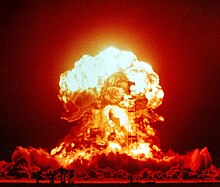
Back تاريخ الأسلحة النووية Arabic Història de les armes nuclears Catalan Historia de las armas nucleares Spanish Histoire de l'arme nucléaire French היסטוריה של הנשק הגרעיני HE 核兵器の歴史 Japanese 핵무기의 역사 Korean ആണവായുധങ്ങളുടെ ചരിത്രം Malayalam Kjernevåpenets historie NB História das armas nucleares Portuguese

| Nuclear weapons |
|---|
 |
| Background |
| Nuclear-armed states |
|
Building on major scientific breakthroughs made during the 1930s, the United Kingdom began the world's first nuclear weapons research project, codenamed Tube Alloys, in 1941, during World War II. The United States, in collaboration with the United Kingdom, initiated the Manhattan Project the following year to build a weapon using nuclear fission. The project also involved Canada.[1] In August 1945, the atomic bombings of Hiroshima and Nagasaki were conducted by the United States, with British consent, against Japan at the close of that war, standing to date as the only use of nuclear weapons in hostilities.
The Soviet Union started development shortly after with their own atomic bomb project, and not long after, both countries were developing even more powerful fusion weapons known as hydrogen bombs. Britain and France built their own systems in the 1950s, and the number of states with nuclear capabilities has gradually grown larger in the decades since.
A nuclear weapon, also known as an atomic bomb, possesses enormous destructive power from nuclear fission, or a combination of fission and fusion reactions.
© MMXXIII Rich X Search. We shall prevail. All rights reserved. Rich X Search